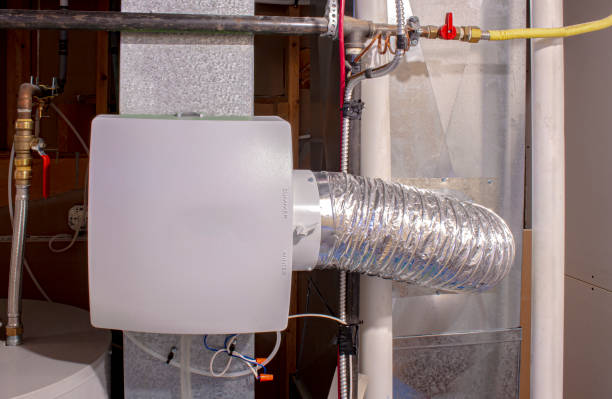A furnace humidifier is an appliance that home inspectors in NJ will see regularly. Home inspectors should have a basic understand of how a humidifier operates and the maintenance involved in its upkeep. NJ home inspectors do not have to inspect these appliances, but it is worthwhile to have a basic understanding of their operation and maintenance. The more information that we can deliver to our clients the better equipped our clients will be when they actually move into the home.
A furnace humidifier is often referred to as a whole house humidifier and ties into the furnace in order to bring air with higher humidify throughout the home. There are three main types of humidifiers that NJ Home Inspectors will come across while performing home inspections. A reservoir type humidifier has a holding tank of water that wets a rotating drum. A steam type humidifier (not very common) heats water to create steam that is delivered into the air flow of the furnace. The most common type of humidifier is a pad type or flow through humidifier. These operate by blowing warm air over a pad that has water trickling down it. Water evaporates and the moisture is absorbed into the air.
The flow through humidifier is usually installed on the supply duct and connects to the hot air supplied by the furnace. There is a small low voltage powered valve called a solenoid valve that allows water to flow over the pad when the humidistat calls for it. The water flows down a corrugated or honeycomb looking pad. Hot air from the furnace blows over the pad receiving the moisture. Any excess water is drained through a tubing then is directed to an approved location such as a sink, standpipe or to the exterior by using a condensation pump.
The water used by the humidifier is supplied by a cold-water line that is installed in close proximity to the humidifier. Often a valve called a saddle valve is used to make this connection. The water line is typically thin copper. Home inspectors in NJ may want to ask the client to consider upgrading the saddle valve to a traditional valve. Saddle valves are prone to leakage over time.
There is a small water valve that is electronic called a solenoid valve. The solenoid valve is controlled by a humidistat which is basically a thermostat for the humidifier. When the humidistat asks for more humidity the solenoid valve opens allowing water to flow into the humidifier wetting the pad inside. When the humidistat senses that enough water has flowed into the unit it will turn the solenoid valve off.
The evaporator pad is the medium inside the humidifier that disperses water evenly and makes the evaporation occur. The pad will also collect any hard water elements and minerals as the water flows on it. After several months of use the pads become white and hardened with mineral deposits. it is best practice to replace these pads to keep them in good working order. The typical replacement schedule for a humidifier pad is about once per year. The replacement is typically done before the heating season starts. If the pad is not replaced, you may find reduced efficiency and less moisture being put into the air. Also, moisture trapped in the old pad can cause bacteria and mold to grow possibly contaminating the air and causing damage to the humidifier unit.
There is also a drain in the humidifier unit. Any unused water runs off the pad and into the drain at the bottom of the humidifier. This is one of the positive attributes of this type of humidifier because there is not standing water in the unit like a reservoir type humidifier. This helps prevent mold growth inside the humidifier.
A humidistat is the control devise for the humidifier. A humidistat works like a thermostat only it controls the amount of moisture that gets put into the air. The desired humidity level is set and when the humidifier reaches that level of humidity the water supply to the unit is turned off by the waver valve on the humidifier.
A humidifier is an option and not a necessity. Dry heat produced by the furnace can cause skin problems, dry noses and sinus conditions. Humidifiers are operated during the heating season only and they should not be operated to excess. Adding too much humidity in the home can create conditions to mold growth.
The rule of thumb for setting a furnace humidifier in the winter is if exterior temperatures are between 20- and 40-degrees Fahrenheit the humidistat should not exceed 40 percent. If the exterior temperatures are 10 degrees to 20 degrees, the humidistat should be set to keep indoor humidity levels at 25-30 percent.
For other than the winter season it is recommended that the humidistat should be set no greater then 30 to 50 percent. Anything greater than 50 percent can lead to creating conditions that are unhealthy in the home.
Furnace humidifiers are an appliance that New Jersey Home inspectors will see often in the homes that they are inspecting. It is up to home inspectors to educate their clients about the benefits of having a furnace and humidifier and its proper maintenance.

